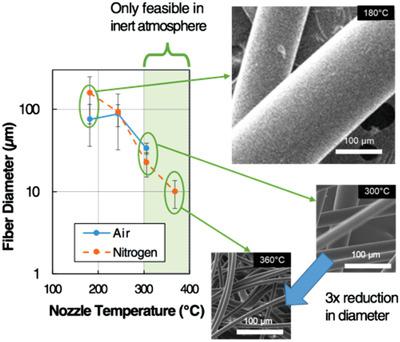当前位置:
X-MOL 学术
›
Macromol. Mater. Eng.
›
论文详情
Our official English website, www.x-mol.net, welcomes your feedback! (Note: you will need to create a separate account there.)
Melt Electrospinning Polyethylene Fibers in Inert Atmosphere
Macromolecular Materials and Engineering ( IF 3.9 ) Pub Date : 2020-09-23 , DOI: 10.1002/mame.202000106 Kai Morikawa 1 , Aniruddh Vashisth 1 , Taruna Bansala 2 , Pawan Verma 2 , Micah J. Green 2 , Mohammad Naraghi 1
Macromolecular Materials and Engineering ( IF 3.9 ) Pub Date : 2020-09-23 , DOI: 10.1002/mame.202000106 Kai Morikawa 1 , Aniruddh Vashisth 1 , Taruna Bansala 2 , Pawan Verma 2 , Micah J. Green 2 , Mohammad Naraghi 1
Affiliation

|
Electrospinning is commonly used for fabrication of polymer fibers. Melt electrospinning, instead of the commonly used solution electrospinning, offers many advantages in generating polymer fibers without using solvents. However, polymer melts have high viscosity which poses major limitations in producing low diameter fibers. Here, melt electrospinning is investigated at elevated temperatures in inert atmosphere to reduce fiber diameters while suppressing thermal degradation. Two types of spinneret configurations, syringe and wire, with two distinct outcomes are studied. In syringe‐based electrospinning, increasing the nozzle temperature from 300 to 360 °C in nitrogen reduced fiber diameter significantly from 33 ± 5 to 10 ± 4 µm. Electrospinning in nitrogen leads to formation of fibers even at a high nozzle temperature of 360 °C, while this temperature leads to thermal degradation when spinning in air. In contrast, increasing the temperature of wire electrospinning setup do not lead to a noticeable reduction in diameter. This is attributed to the viscosity‐dependent flow rate in this method. Increasing the temperature leads to increased flow rates, promoting the formation of thicker fibers, while the increased stretchability promotes the formation of thinner fibers. The results clearly demonstrate advantages of developing polymer microfibers in inert atmosphere to avoid thermal degradation with a temperature‐independent flow control.
中文翻译:

惰性气氛中的熔融静电纺丝聚乙烯纤维
电纺丝通常用于制造聚合物纤维。熔融电纺而不是通常使用的溶液电纺,在不使用溶剂的情况下产生聚合物纤维方面具有许多优点。然而,聚合物熔体具有高粘度,这在生产低直径纤维方面提出了主要限制。在此,在惰性气氛中在高温下研究熔体静电纺丝,以减小纤维直径,同时抑制热降解。研究了两种类型的喷丝头配置,注射器和金属丝,具有两种不同的结果。在基于注射器的静电纺丝中,在氮气中将喷嘴温度从300°C升高至360°C,可使纤维直径从33±5 µm显着降低。即使在360°C的高喷嘴温度下,氮气中的静电纺丝也会导致纤维形成,而在空气中旋转时,此温度会导致热降解。相反,增加线电纺丝设置的温度不会导致直径明显减小。这归因于此方法中取决于粘度的流速。温度升高导致流速增加,从而促进了较粗纤维的形成,而拉伸性的提高则促进了较细纤维的形成。结果清楚地表明了在惰性气氛下开发聚合物微纤维的优势,可避免与温度无关的流量控制引起的热降解。这归因于此方法中取决于粘度的流速。温度升高导致流速增加,从而促进了较粗纤维的形成,而拉伸性的提高则促进了较细纤维的形成。结果清楚地表明了在惰性气氛下开发聚合物微纤维的优势,可避免与温度无关的流量控制引起的热降解。这归因于此方法中取决于粘度的流速。温度升高导致流速增加,从而促进了较粗纤维的形成,而拉伸性的提高则促进了较细纤维的形成。结果清楚地表明了在惰性气氛下开发聚合物微纤维的优势,可避免与温度无关的流量控制引起的热降解。
更新日期:2020-09-23
中文翻译:

惰性气氛中的熔融静电纺丝聚乙烯纤维
电纺丝通常用于制造聚合物纤维。熔融电纺而不是通常使用的溶液电纺,在不使用溶剂的情况下产生聚合物纤维方面具有许多优点。然而,聚合物熔体具有高粘度,这在生产低直径纤维方面提出了主要限制。在此,在惰性气氛中在高温下研究熔体静电纺丝,以减小纤维直径,同时抑制热降解。研究了两种类型的喷丝头配置,注射器和金属丝,具有两种不同的结果。在基于注射器的静电纺丝中,在氮气中将喷嘴温度从300°C升高至360°C,可使纤维直径从33±5 µm显着降低。即使在360°C的高喷嘴温度下,氮气中的静电纺丝也会导致纤维形成,而在空气中旋转时,此温度会导致热降解。相反,增加线电纺丝设置的温度不会导致直径明显减小。这归因于此方法中取决于粘度的流速。温度升高导致流速增加,从而促进了较粗纤维的形成,而拉伸性的提高则促进了较细纤维的形成。结果清楚地表明了在惰性气氛下开发聚合物微纤维的优势,可避免与温度无关的流量控制引起的热降解。这归因于此方法中取决于粘度的流速。温度升高导致流速增加,从而促进了较粗纤维的形成,而拉伸性的提高则促进了较细纤维的形成。结果清楚地表明了在惰性气氛下开发聚合物微纤维的优势,可避免与温度无关的流量控制引起的热降解。这归因于此方法中取决于粘度的流速。温度升高导致流速增加,从而促进了较粗纤维的形成,而拉伸性的提高则促进了较细纤维的形成。结果清楚地表明了在惰性气氛下开发聚合物微纤维的优势,可避免与温度无关的流量控制引起的热降解。

























 京公网安备 11010802027423号
京公网安备 11010802027423号